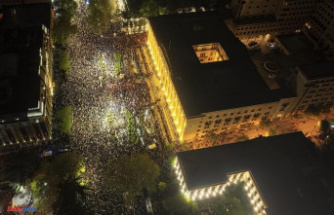asteroid 2000 QW7 , a rock of 300 to 600 meters in diameter, a length equivalent to six football fields placed one followed by the other, will come this evening to the Land. The closest approach will fail to 1.54 of Sunday morning, about 5 million kilometers. The distance is more than enough to ensure that this ride will not pose any danger. However, scientists believe that it is necessary to keep the eye on this rock, because its orbit around the Sun will pass repeatedly over the years about our planet, and someday, in the distant future, may represent a real risk.
2000 QW7 was discovered by NASA on August 8, 2000. Orbit around the Sun, but we only crossed with him sporadically. The last time was the 1 of September of the year 2000. After tonight, the next time that you are waiting is the 19 of October of 2038, according to the jet Propulsion Laboratory (JPL) of NASA.
On this occasion, will pass within 0,03564 astronomical units of the Earth, which is equivalent to about 5 million kilometers. In other words, nearly 14 times the distance that separates us from the Moon. Quite far away. According to B612, and the Institute of Asteroids, a non-governmental organization dedicated to protecting the planet from asteroid impacts, there is a large uncertainty in the size of the new visitor, so that his arrival may serve to get to know him better.
The half, located
The foundation, explains that, in general terms, astronomers have identified and traced about half of the asteroids in the solar system internal in this size range.
The good news is that there are currently a number of observatories around the world dedicated to the tracking of asteroids 2000 QW7. Soon will be deployed megatelescopios, as the Great Telescope to Study the Synoptic (LSST) -that will begin running in 2022-that promise to make a substantial contribution to the population crawled from large asteroids near the Earth to about 140 meters in diameter. However, millions of smaller rocks, much more difficult to see, in less than 140 metres, will require new technologies and techniques.
We will be beatenBut it is not necessary to be alarmed. "Remember that the Earth is covered in large part by our oceans and is largely depopulated, so that the probability of being hit is extremely low. But the fact is that we, as human beings, we have the ability to find them and lead them astray; the question is whether or not we have the will to fund the work," says Danica Remy, president of the foundation B612
As explained, the telescopes funded by NASA are finding around 2,000 asteroids a year. The agency and other telescopes have found together around 20,000, but there are millions of asteroids below 140 metres, more difficult to see, that have not yet been found.
B612 is building a dynamic map integral of the solar system to identify the location and trajectory of asteroids, exploration, and planetary defense. "It is one hundred percent sure that we will be beaten, but we are not one hundred percent sure when, so we need to accelerate the rate of discovery of asteroids," says Remy.
Date Of Update: 15 September 2019, 00:00











